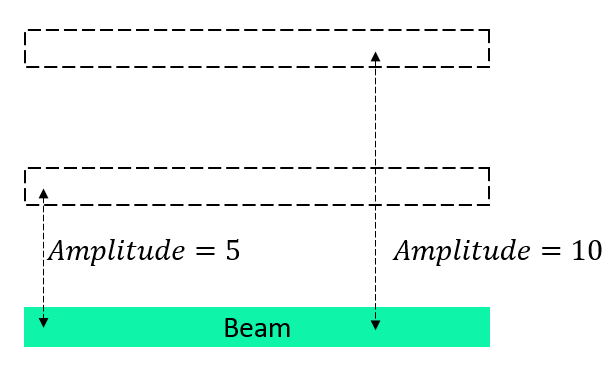Principles of eigen period analysis in AquaSim
Last reviewed version: 2.19In AquaSim, one has the possibility to apply eigen period analyses through the option Buckling /eigen period analysis found in the Export menu. This is illustrated in the figure below.

By selecting the three dots […] to the right (see the figure above), one enters the control window for eigen period settings.

The parameters in the figure above should be defined prior to the analysis and are described in the succeeding sections
Analysis type
Eigen period analysis solves the equation:
$${K - \omega^2 M = 0}$$
where K is the stiffness for the structural configuration at the given analysis timestep, M is the mass of the structural configuration at the same timestep. The result that is found is the eigen value λ=ω^2, which is the eigen frequency, and \( T = \frac{2\pi}{\omega} \) is then the eigen period.
Please note that in the AquaSim-eigen-period-analysis mass of water inside any modelled container is accounted for. Mass of Membranes are not included, except from Shell where this is accounted for.
Analysis type provides four different options:
-
Buckling: calculation of buckling modes (not a topic of this tutorial).
-
Eigen periods (excluding mass of truss elements): this analysis type exclude the effect of mass in truss elements. Then M, in the formula above, will equal to zero for truss elements. Due to the nature of truss elements (which normally are slim and not very stiff), AquaSim may find numerous of eigen periods. All these periods can be perceived as “noise”. If your model includes truss elements, but they are not an essential part of your eigen period investigation, you may choose this analysis type. One example could be eigen period study of a moored barge or ship, where the mooring lines are modelled as truss elements.
-
Eigen periods (including mass of truss elements): this analysis type includes the effect of mass in truss elements. Then M, in the formula above, will not equal to zero. This analysis type can be useful to apply if you have a model where truss elements are a part of your eigen period study, e.g. framework construction such as masts or bridges.
-
Eigen periods (excluding mass of truss elements and mass caused by nodal loads): if your model includes component type truss and Pointloads, this analysis type will not include the effect of mass in trusses and mass from Pointloads. If you have a model with Pointload that is for example applied as a bottom weight on mooring lines, one may risk ending up with numerous of eigen periods. As for the first analysis type, this one is useful to apply if your model contain both truss elements and Pointloads, but they are not essential for your eigen period study.
Amount of eigenvalues written to file
AquaSim may report up to six positive eigen periods to the result files. Amount of eigen values written to file must be a number that is higher than 0 and lower than 7. If this parameter is equal to 3, then the three eigen periods that is closes to the Shift value is calculated.
Positive eigenvalues closest to 0 to omit
How many positive eigen values closest to 0 that shall be omitted in the results written to file.
Amplitude of the eigen vectors
The amplitude of the eigen vectors. The eigen vector indicates the direction of motion for the calculated eigen period. This parameter is unitless and can be interpreted as an amplification factor for the eigen vector. It makes is easier to identify the direction of the eigen value and evaluate the results. An example is illustrated below: a beam with two different values for the eigen vectors.

Shift value
Shift value is where calculated eigen values are centered around. The lowest frequencies (i.e. the highest periods) of the structure is aimed for if this parameter is 0. It pinpoints the area in which one wish to find eigen periods.
Stress value
This option is not currently available to use in AquaSim.
Analysis valid for
What type of materials the analysis should be conducted for. Two options are available:
-
Valid for linear materials (nonlinear motions and rotations are ok): only material data from Material/ section properties are considered in the analysis. Potential nonlinear relation from NLD-tables is not considered when calculating eigen values.
-
General, but noiser buckling response: materials with both linear and nonlinear relations are included in the eigen value analysis. Please note that AquaSim may find numerous of eigen values when this is selected, and can be perceived as “noise”.
Calculations and results
To include eigen period study when conducting an AquaSim-analysis, the user should select the checkbox for Buckling /eigen period analysis. The user then exports the model and run an analysis as for ordinary analyses, see figure below.

Eigen period studies can be run for static as well as dynamic problems. Meaning that the effect of current, wind and waves can be included in your eigen period study.
Having carried out the analysis, some additional result files will be generated, they are presented in the figure below.

The <filename>eigen1.avz will include the results for the eigen value closest to Shift value. Please note that each step in the analysis is considered separately, such that each step must be evaluated by the user. The <filename>eigen2.avz contain results for the eigen value second closest to Shift value, and so on.